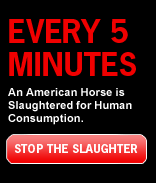The Wallis' "Slaughterhouse Sue," Gang Rides Again;
Negotiations begin in horse slaughter plan
An organization is in talks with the Wyoming Livestock Board about taking over stockyards across from the former Hitching Post Inn, where horses would stay before being shipped off for possible slaughter at a yet-to-be-determined site.
By Michael Van Cassell
mcassell@wyomingnews.com
CHEYENNE -- A Wyoming state legislator with designs to start a horse slaughter operation said Monday it would be part of a broader plan to rescue abandoned or unwanted horses.
Rep. Sue Wallis, R-Recluse, said the nonprofit United Organizations of the Horse would accept donated horses, either from the Wyoming Livestock Board or individuals. She referenced a lot of about 230 feral horses the Wyoming Livestock Board sold recently for $1 each during a public sale in Rock Springs.
Horses would be evaluated and either sent to rehabilitation, rejuvenation or slaughter, according to Wallis.
"We think that we will probably work up to the point where we're killing 20 horses a day," she said.
Wallis said that since slaughter was taken off the table as an option for horses in America, the industry has fallen on hard times.
"Many of us believe that the best and responsible solution is humane slaughter and good use of that meat," she said.
Wallis said the organization has started negotiations with the Wyoming Livestock Board to take over the Cheyenne stockyards across West Lincolnway from the former Hitching Post Inn.
"It is not where we are going to slaughter horses," Wallis said. She described it as being somewhat of an intake facility.
Wallis envisions a mobile slaughter operation that can be taken to different areas of the state. She said one exists in South Dakota for buffalo.
She said they are working with Temple Grandin, an animal behaviorist at Colorado State University in Fort Collins, Colo., on designing a humane slaughter process.
The meat would primarily be marketed for zoo feed and pet diets, Wallis said.
"And we already have customers for those products," she said.
She believes there may be a small market for human consumption within the state.
Wallis said she has eaten horse meat on a trip to Canada and found it tasted good and was tender.
"The rest of the world just sees this as an ordinary food source," she said.
It is unclear whether the federal government would consider horse products legal to enter commerce for human consumption, even within the state.
Congress yanked the U.S. Department of Agriculture's funding to inspect horse slaughterhouses in 2006, effectively shutting down such operations. The USDA cannot get involved.
Interstate distribution of meat is barred.
The particulars of canning the meat have yet to be worked out, according to Wallis.
"We are still evaluating possible locations, but it will probably be an existing meat processing facility somewhere in the state," she said.
Dale Steenbergen, president and chief executive officer of the Greater Cheyenne Chamber of Commerce, said if the possibility of a slaughterhouse coming to Cheyenne becomes more than a rumor, then the chamber may discuss it.
On a personal note, Steenbergen, who is involved in ranching, said it would be good to have some discussion on what to do with abandoned horses.
He said that he had one turned out on him last year.
"Is it better to starve them to death or put them down humanely?" he said. "We've got to figure out something to do because this is a huge, huge problem."
The plan has caused a stir among the state's animal welfare and animal rights activists, who question both the legality and morality of such a slaughterhouse.
Patricia Fazio, who has been involved with animal welfare issues at the state and local level in Wyoming since 1994, said horses are not meat animals like cattle.
Fazio said horse meat can be contaminated and is not safe for consumption.
She also questioned how big of a problem abandoned horses are.
"Our conclusion is it's kind of a ploy that they're using," she said.
Fazio said there are other horse rescue operations operating in the West.
"There is no need to do horse slaughter," she said.
"I agree there are some animals that are sick or beyond helping from a medical point of view we should just be euthanizing," she said.
Jeannine Stallings, a Cheyenne resident who is the founder and president of Wyoming Advocates for Animals, said she is disgusted by the idea of a horse slaughter and cannery.
"I just can't believe anyone can be so mean spirited as to even consider such an idea," she said.
http://www.wyomingnews.com/articles/2010/04/28/news/19local_04-28-10.txt
AQHA Asks Congress to Support Horse Slaughter
14 years ago























